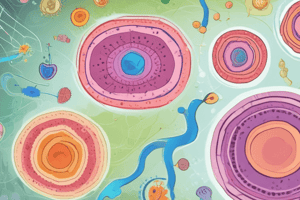Podcast
Questions and Answers
What is the main function of ribosomes in a cell?
What is the main function of ribosomes in a cell?
- Lipids synthesis
- Protein synthesis (correct)
- Modify proteins
- DNA replication
Which structure is responsible for the production of ATP through aerobic respiration?
Which structure is responsible for the production of ATP through aerobic respiration?
- Mitochondrion (correct)
- Lysosome
- Golgi Apparatus
- Rough Endoplasmic Reticulum
What is the role of the Golgi Apparatus in a cell?
What is the role of the Golgi Apparatus in a cell?
- Packages and modifies proteins (correct)
- Digests cellular waste
- Synthesizes lipids
- Stores genetic material
Which type of membrane transport does not require energy?
Which type of membrane transport does not require energy?
What happens to a cell placed in a hypertonic solution?
What happens to a cell placed in a hypertonic solution?
How do gated channels function in the cell membrane?
How do gated channels function in the cell membrane?
Which organelle is primarily involved in lipid synthesis?
Which organelle is primarily involved in lipid synthesis?
What is the function of microvilli in a cell?
What is the function of microvilli in a cell?
Study Notes
Cell Structure and Function
- Cells serve as the fundamental living units of all organisms, extremely small in size.
- Organelles are specialized structures within the cell, functioning like organs.
Cytoplasm
- Cytoplasm is the internal environment where organelles reside, providing a medium for cellular processes.
Cell Membrane
- The cell membrane acts as the outer protective layer.
- It features a Fluid Mosaic Model, which describes the dynamic arrangement of molecules.
- Contains Receptor Molecules to facilitate cell communication and recognition.
- Characterized as Selectively Permeable, allowing selective movement of substances.
Nucleus
- The nucleus contains the cell's genetic material, governing cellular function and heredity.
Ribosomes
- Ribosomes are essential for protein synthesis, critical for cell structure and function.
Endoplasmic Reticulum (ER)
- Rough ER is involved in protein synthesis, with ribosomes attached to its surface.
- Smooth ER synthesizes lipids, contributing to membrane production and metabolism.
Golgi Apparatus
- The Golgi apparatus modifies protein structures and packages them into secretory vesicles for transport.
Secretory Vesicle
- Secretory vesicles store and transport materials produced by the cell, facilitating secretion.
Peroxisome
- Peroxisomes break down fatty acids, hydrogen peroxide, and amino acids, playing a role in detoxification.
Lysosome
- Lysosomes contain digestive enzymes to break down materials ingested by the cell.
Mitochondrion
- Mitochondria are known as the "powerhouses" of the cell, producing ATP through aerobic respiration.
Cytoskeleton Components
- Microtubules provide structural support for the cytoplasm.
- Centrioles aid in cell division by organizing the microtubule spindle fibers.
- Cilia and Flagella enable movement; cilia move substances across the cell surface, while flagella propel the cell itself.
- Microvilli increase the surface area for absorption and secretion.
Cell Metabolism
- Cell metabolism encompasses molecule synthesis, communication processes, and reproduction, including both mitosis and meiosis.
Cell Membrane Functions
- The cell membrane regulates ion movement through Gated Channels (which can open or close) and Leaked Channels (which remain open).
Movement Across the Cell Membrane
- Passive transport includes diffusion, osmosis, and facilitated diffusion, requiring no energy.
- Active transport involves energy expenditure for moving substances against their concentration gradient through methods like active transport and exocytosis.
Key Transport Concepts
- Diffusion involves solutes moving from high to low concentration.
- Osmosis is the movement of solvents from a higher to a lower concentration area.
- Osmotic pressure is necessary to prevent water movement across semipermeable membranes.
Solutions and Cell Response
- Hypotonic solutions cause cells to swell due to solvent influx.
- Hypertonic solutions lead to cell shrinkage as solutes draw out solvent.
- Lysis refers to cell rupture due to excessive swelling.
- Crenation describes the shriveling of red blood cells (RBC) in hypertonic conditions.
Studying That Suits You
Use AI to generate personalized quizzes and flashcards to suit your learning preferences.
Description
This quiz covers the fundamental concepts of cell structure and function, including organelles, cytoplasm, and the cell membrane. Test your knowledge on essential cell components and their roles in living organisms.




